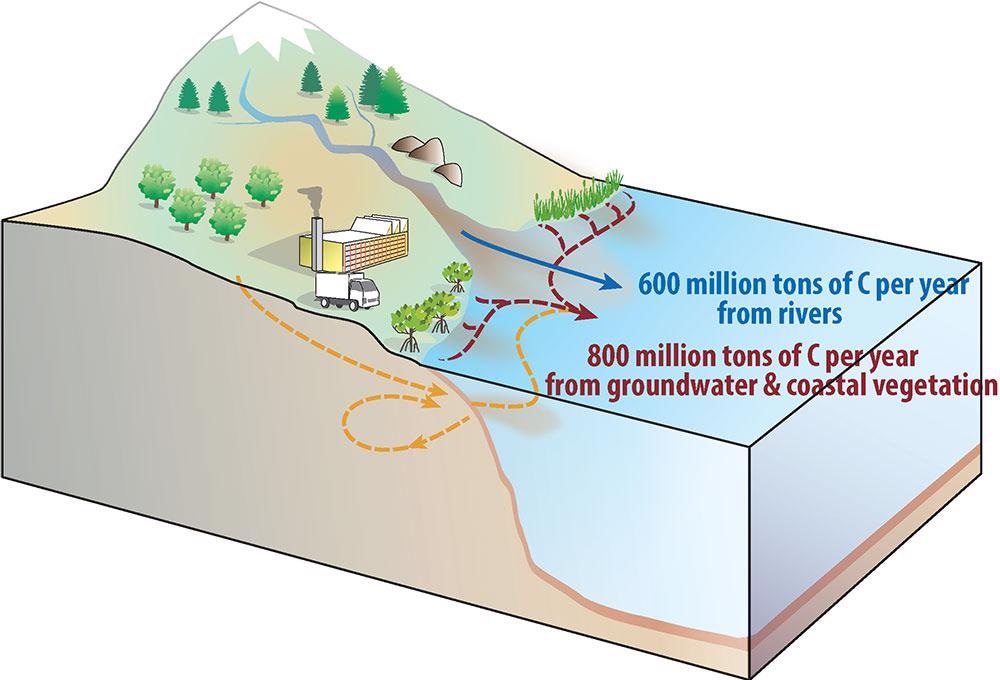Mar 19 2021
Around 600 to 900 million tons of carbon flow into the ocean every year via rivers either as particles or in dissolved form.
 Schematic figure showing the new estimates of river, groundwater, and coastal ecosystem carbon transport from land to ocean. Image Credit: Eun Young Kwon.
Schematic figure showing the new estimates of river, groundwater, and coastal ecosystem carbon transport from land to ocean. Image Credit: Eun Young Kwon.
For a long time, scientists have been well aware that this does not constitute the entire amount of carbon that gets carried away from the land to the ocean. However, the leftover contributors mainly from coastal ecosystems, like carbon-rich mangrove forests, and from groundwater discharge into the ocean have been notoriously hard to quantify.
Published in the Global Biogeochemical Cycles journal and led by Dr Eun Young Kwon, project leader at the Institute for Basic Science (IBS) Center for Climate Physics South Korea, a new study now offers fresh estimates of this elusive component of the global carbon cycle.
The study utilizes the presence of two stable carbon isotopes, 12C and 13C, where the latter is slightly heavier as it consists of an additional neutron in its nucleus.
The concentration ratio between the two carbon isotopes (called δ13C) offers a way to monitor carbon via the various components of the carbon cycle, such as the oceans, river systems, atmosphere and the biosphere.
With the knowledge of the standard δ13C value of land biosphere and for coastal vegetation, the way this amount gets diluted in the oceans can now be monitored.
The carbon isotope values act like an invisible dye that tells us something about the source where it came from and how much got released initially.
Dr Eun Young Kwon, Study Lead Author and Project Leader, Center for Climate Physics, Institute for Basic Science
Dr Kwon together with her international team employed oceanic observations of δ13C and ocean current estimates and could evaluate the amount of carbon that would have to come from the land to account for the ocean data.
The estimations are somewhat more complex since carbon can also get deposited as sediment in the deep ocean or outgas to the air. The burning of fossil fuels also alters the δ13C of atmospheric and finally oceanic carbon.
Once these impacts are taken into account, the researchers were ready for a surprise: much higher numbers were found for the land-to-ocean carbon transfer of 900 to1900 million tons annually.
The majority of the non-riverine carbon inputs of around 300 to 1300 million tons of carbon annually take place mainly along the coastlines of the Pacific and Indian Oceans.
This is consistent with the idea that groundwater discharge and coastal ecosystems, the so-called blue carbon, play a fundamental role in the global carbon cycle.
Dr Eun Young Kwon, Study Lead Author and Project Leader, Center for Climate Physics, Institute for Basic Science
One of the open questions is which oceanic processes are behind the transport of the dissolved carbon from the coastal zones to the open ocean, where part of it outgases back to the air.
This question will be addressed in future with a series of new earth system model simulations that we just conducted on our supercomputer Aleph.
Axel Timmermann, Study Co-Author and Director, Center for Climate Physics, Institute for Basic Science
Journal Reference:
Kwon, E. Y., et al. (2021) Stable Carbon Isotopes Suggest Large Terrestrial Carbon Inputs to the Global Ocean. Global Biogeochemical Cycles. doi.org/10.1029/2020GB006684.